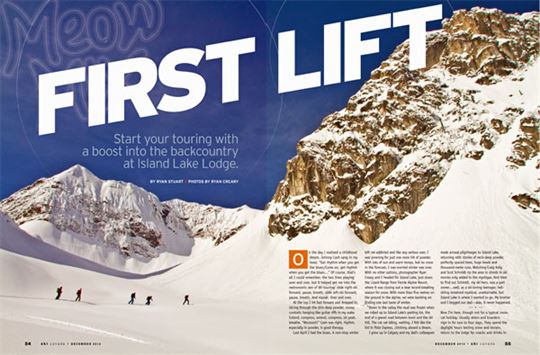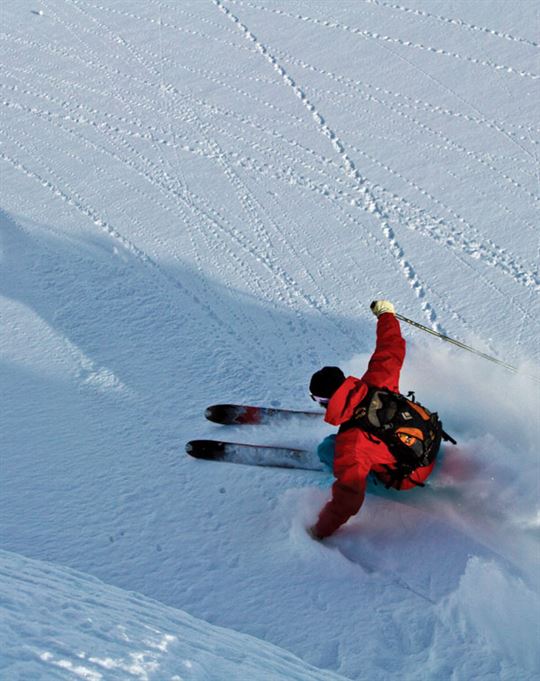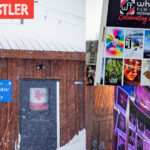Start your touring with a boost into the backcountry at Island Lake Lodge.
by Ryan Stuart in December 2012 issue

On the day I realized a childhood dream, Johnny Cash sang in my head. “Get rhythm when you get the blues/Come on, get rhythm when you get the blues…” Of course, that’s all I could remember, the two lines playing over and over, but it helped get me into the metronomic zen of ski touring: slide right-ski forward, pause, breath, slide left-ski forward, pause, breath. And repeat. Over and over.
At the top I hit fast forward and dropped in, slicing through the shin-deep powder, snowy contrails hanging like guitar riffs in my wake. Extend, compress, extend, compress, oh yeah, breathe. “Woooooh!” Cash was right, rhythm, especially in powder, is good therapy.
Last April I had the blues. A non-stop winter left me addicted and like any serious user, I was jonesing for just one more hit of powder. With lots of sun and warm temps, but no snow in the forecast, I was worried winter was over. With no other options, photographer Ryan Creary and I headed for Island Lake, just down the Lizard Range from Fernie Alpine Resort, where it was closing out a near record-breaking season for snow. With more than five metres on the ground in the alpine, we were banking on finding one last taste of winter.
Down in the valley the mud was frozen when we rolled up to Island Lake’s parking lot, the end of a gravel road between town and the ski hill. The cat sat idling, waiting. I felt like the kid in Polar Express, climbing aboard a dream.
I grew up in Calgary and my dad’s colleagues made annual pilgrimages to Island Lake, returning with stories of neck-deep powder, perfectly spaced trees, huge bowls and thousand-metre runs. Watching Craig Kelly and Scot Schmidt rip the area to shreds in ski movies only added to the mystique. And then to find out Schmidt, my ski hero, was a part owner…well, as a ski-loving teenager, heli-skiing remained mystical, unattainable, but Island Lake is where I wanted to go. My brother and I begged our dad—alas, it never happened.
— + —

Now I’m here, though not for a typical snow-cat holiday. Usually skiers and boarders sign in for two to four days. They spend the daylight hours testing snow and terrain, return to the lodge for snacks and drinks in the bar, maybe shoot a game of pool, soak in the hot tubs or hit the spa. Later they slide up to a gourmet menu (and 3,000-bottle wine cellar) and relax in the most cozy and luxe digs in Canadian cat-country. Despite deep snow and plenty of powder, demand for multi-day trips runs out by the end of March. To take advantage of the quality conditions Island Lake added day-skiing to its shoulder-season menu and now, what we have come to sample for the day, cat-assisted ski touring.
The snowcat provides the first 600 metres or so of sweat-free climbing and then the group, led by a veteran mountain guide, heads out, and up, to earn more turns. At about $150 per person it’s the cheapest way to sample Island Lake’s snow and impressive terrain and, Doug Freely tells me, a return to Island Lake’s roots.
Freely, the CEO of the Island Lake Lodge Group, which includes Island Lake Catskiing and Mica Heliskiing, joins us along with two guides after a quick safety briefing. Now we’re in the cat climbing to our drop-off and Freely is giving me a quick history lesson.
“Island Lake started as a ski-touring area,” he tells me. “They built the Bear Lodge and the terrain is obvious. But the next year they discovered the PistenBully and the rest is history.” He laughs.
That was 25 years ago this winter. Cat-skiing started in 1988 when one of the owners bought the first snowcat and roads were cut into the unlogged forest above Island Lake Lodge. Slowly the legend grew. Unlike other operations on crown land, Island Lake bought the 2,800-hectare property in 1994, becoming the first B.C. cat operation to own its ski terrain. Today there’s room for 36 guests in four cushy and inviting log-cabin-style buildings, three for accommodation and one for entertainment. There’s a spa, an expansive restaurant and a bar with one of the best deck’s in ski country. “Food is what we’re known for,” says Freely. “We’re quite proud of it.” I can vouch for that. Later, I devour a third helping of an aprés-ski snack of homemade soup, a hearty curried lentil of perfect consistency and just enough spice to wake up the taste buds. I mopped up the remains with a piece of fresh focaccia bread.
When Freely shows us the lodging, I resist the urge to immediately snuggle in for a nap in one of the empty rooms. They’ve gone for a chic mountain-cabin look with warm slate floors, lots of exposed wood, and inviting beds with thick, fluffy duvets and big pillows.
Back in the cat, I’m making further plans to return for an overnight stay. Every summer over the last 25 years the old-growth forest has been carefully gladed by a team led by one of the lodge’s veteran guides. I drool at the quality of the work as the cat makes a kilometre-long switchback across the slope opposite the lodge; perfectly spaced trees fall away steeply. Across the valley I can see even more of Island Lake’s runs: on Mt. Fernie and Baldy, including pitches of gladed trees stretching from peak to valley, some even ending just behind the lodge. It looks like epic storm-skiing terrain.
The cat finally stops at the base of Baby Bear Bowl. As inviting as the trees look, the alpine is even more alluring. We begin skinning toward it, Rick Emmerson, one of the lead cat-skiing guides, breaking trail through 15 cm of light new snow.
“April is typically a really good time for ski touring in the Lizard Range,” Emmerson says. “The stability is usually good, the weather tends to be stable and there’s still plenty of dry snow up high.” He decides we’ll stick to the Lizard Range side today, where the terrain and scenery are spectacular.
As we methodically work our way up, Johnny Cash starts playing in my head again. Forty minutes later we stand in a small pass looking down a perfect blanket of crystals. There’s not a track in site.

The blank canvas begs to be trashed and we oblige, each of us finding our own personal line. Through the shade I arc back and forth, purposefully digging in on the downhill to blow snow high in the air and then turning into it for a little face wash of floating stellars. Thoroughly refreshed, the blues fading, I ski to the skin track for another lap.
After two runs in Baby Bear, we hop the ridge to Nonstop. Here the terrain is mellower and more open. I press on the gas pedal and open the turns to super-G. With skis singing over the snow, I feel as if I’m flying as I weave a line back to the cat road, where we regroup with high-fives and fist bumps, adrenaline lighting up all our faces.
The day disappears as we continue to wander across Island Lake’s terrain. The place is a giant playground. Steep short chutes, long open tree runs, massive bowls, rolls and wind lips, spines, cornices, cliffs—it’s all there. And encompassing every possible aspect, there’s always good snow to be found. With south- and west-facing terrain turning soggy in the sun, we stick to east and north aspects, laying tracks in the shady alpine bowls beneath the Lizard Range.
The dominant feature of the area, the Lizard Range—making up all of Fernie Alpine Resort and a good chunk of Island Lake—is more of a long ridge running almost north-south, creating a micro-climate. In the Canadian Rockies most storms come from the west. North and west the Coast Range and Columbia Mountains (Purcells, Monashees and Selkirks) sponge out most of the clouds before they hit the Rockies. But west of Fernie the Columbia’s are only rolling hills, leaving clouds laden. After crossing the dry plains near Cranbrook, storms are suddenly forced up and over the Lizard Range, typically dumping copious quantities of snow on places like Fernie and Island Lake.
Today there are no storm clouds to be seen. The expansive ski area spreads out before us on our last run. If we were on a cat-ski trip, our day wouldn’t have been that different—just more skiing and less climbing—as we tracked up the best lines for the conditions.
We get a sense of what it would be like mid-winter when we polish the day, and my legs, with Snowboard Heaven, a long run from alpine to valley bottom, the snow staying dry until the last few hundred metres. Back at the lodge, a few minutes later, we crack a beer and grab a bowl of homemade soup.
“This is how we end every day,” says Freely, sliding on a pair of shades between sips of beer on the Bear Lodge deck. We’re looking right at the Lizard Range, our tracks scribbles across the canvas. I pull up a chair next to him and take my first sip of soup, scalding my tongue. I know my blues are gone, at least for another day, as another Johnny Cash song pops into my head. “And it burns, burns, burns/the ring of fire/the ring of fire.”
Cat facts
Season: December to March for multi-day cat-ski tours, and April for day cat-skiing and cat-assisted touring.
Cost: Cat-assisted ski touring starts at $150 per person in a group of 4 or 5, and includes a cat ride to and from the lodge, morning snacks and drinks, one 2,000-foot first lift, a full day of guiding and an après beer and snack; a two-day cat-skiing package starts at $1,500.
Average vertical per day: Ski touring, up to 5,000 feet on top of the 2,000-foot first lift; cat skiing, 15,000 feet.
Average snowfall: Nine to 12 metres per winter; snowpack of three to four metres.
Do your homework: Read up on Island Lake history, especially its food, in Island Lake Lodge: The Cookbook (whitecap.ca). You can also sample head chef Keith Frakas’s delectable creations at the Picnic Restaurant in Fernie (picnicrestaurant.ca).
islandlakelodge.com




